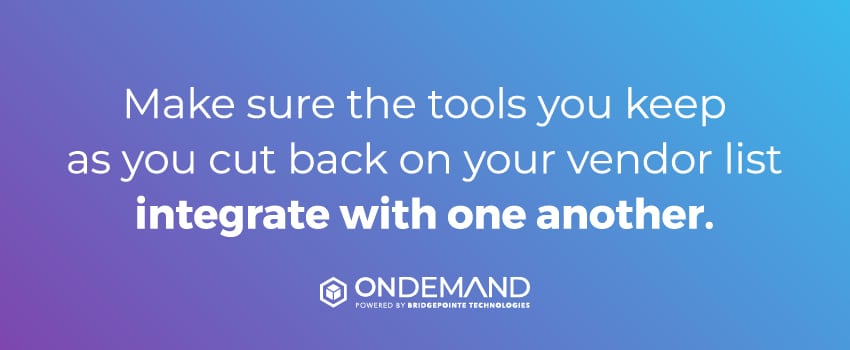As your business grows and adopts more technology, it can be easy to end up working with a long list of vendors. One provider handles your phones, another your cloud storage, and others manage your cybersecurity, network, or software licenses. Over time, what started as a few well-chosen solutions becomes hard to track and even harder to manage, which could be why 82% of enterprises are currently pursuing supplier reduction.1
This problem is called vendor sprawl, and it often leads to confusion, delays, and added costs. Read on for a few actionable steps to help you consolidate vendors, reduce clutter, and feel more in control of your technology management.
What Are the Risks of Vendor Sprawl?
Managing multiple vendors doesn’t just take time; it can slow your entire team down. Here are a few common challenges that come with vendor sprawl:
- Inefficiency: Switching between platforms, portals, and support teams slows down internal workflows and troubleshooting.
- Hidden Costs: Overlapping services, underused licenses, and variable billing structures make it hard to track true spend.
- Security Gaps: Disconnected systems and inconsistent policies increase the risk of data exposure or compliance failures.
- Employee Burnout: Keeping up with constant vendor coordination, ticketing, and system workarounds can wear teams down, with 60% of IT professionals in a 2025 survey saying they experience burnout at work.2
- Limited Scalability: Coordinating multiple vendors becomes even harder as your business expands or merges.
Ultimately, if managing your vendor list has started to feel overwhelming, then it’s time to simplify.

6 Tips for Seamless Vendor Consolidation
You don’t have to start from scratch to get your IT vendor management under control. Here are a few tips to help you get started:
1. Start With an Audit
Take a look at which vendors you’re currently working with, what services they provide, and how much you’re spending. Auditing your IT vendors will give you a clearer picture of where there may be overlap or services that no longer align with your needs.
2. Eliminate Redundancies
Many enterprise-grade vendors now offer bundled solutions that cover multiple needs – so if you’re using separate providers for services like voice, cloud storage, and endpoint security, it may be possible to combine them under one roof.
3. Standardize Contracts and SLAs
Consolidating your vendors means you’ll have fewer contracts to manage, which is a great opportunity to streamline things. Set consistent service level expectations, renewal timelines, and support terms to make each relationship easier to manage over time.
4. Prioritize Interoperability
Make sure the tools you keep as you cut back on your vendor list integrate with one another. When your systems work together, your teams can spend less time troubleshooting and more time getting things done.

5. Evaluate Long-Term Fit
Don’t just consolidate your vendors with short-term savings in mind. Choose providers that offer scalable, future-proof solutions, not just the latest technologies, to get the most value out of your efforts.
6. Leverage Centralized Support
When you work with fewer providers, you know exactly who to contact when you need to resolve performance or billing issues. A centralized support model makes life easier for both IT teams and end users.
OnDemand: Technology Procurement That Works for You
Simplifying your IT vendor management doesn’t have to mean limiting your options. By making smart, thoughtful choices about your technology procurement, you can reduce complexity across your infrastructure and support your organization’s long-term growth.
OnDemand, powered by Bridgepointe Technologies, makes it easy to manage business technology with confidence. Our vendor-agnostic teams combine deep industry knowledge with real-world experience to help you consolidate providers and source the tech solutions that meet your unique needs.
Ready to take the complexity out of IT vendor management? Contact OnDemand today.
Sources:
